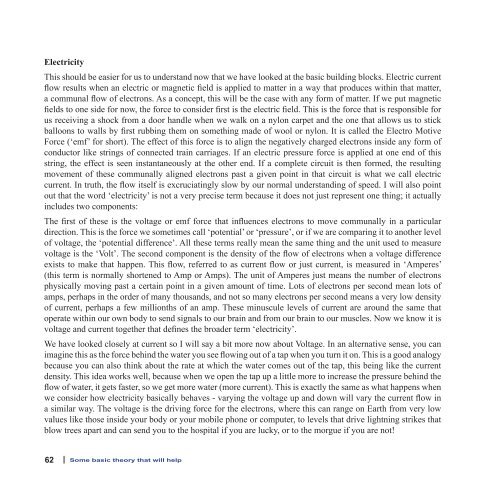A Beginner's View of Our Electric Universe - New
A Beginner's View of Our Electric Universe - New
A Beginner's View of Our Electric Universe - New
You also want an ePaper? Increase the reach of your titles
YUMPU automatically turns print PDFs into web optimized ePapers that Google loves.
<strong>Electric</strong>ity<br />
This should be easier for us to understand now that we have looked at the basic building blocks. <strong>Electric</strong> current<br />
flow results when an electric or magnetic field is applied to matter in a way that produces within that matter,<br />
a communal flow <strong>of</strong> electrons. As a concept, this will be the case with any form <strong>of</strong> matter. If we put magnetic<br />
fields to one side for now, the force to consider first is the electric field. This is the force that is responsible for<br />
us receiving a shock from a door handle when we walk on a nylon carpet and the one that allows us to stick<br />
balloons to walls by first rubbing them on something made <strong>of</strong> wool or nylon. It is called the Electro Motive<br />
Force (‘emf’ for short). The effect <strong>of</strong> this force is to align the negatively charged electrons inside any form <strong>of</strong><br />
conductor like strings <strong>of</strong> connected train carriages. If an electric pressure force is applied at one end <strong>of</strong> this<br />
string, the effect is seen instantaneously at the other end. If a complete circuit is then formed, the resulting<br />
movement <strong>of</strong> these communally aligned electrons past a given point in that circuit is what we call electric<br />
current. In truth, the flow itself is excruciatingly slow by our normal understanding <strong>of</strong> speed. I will also point<br />
out that the word ‘electricity’ is not a very precise term because it does not just represent one thing; it actually<br />
includes two components:<br />
The first <strong>of</strong> these is the voltage or emf force that influences electrons to move communally in a particular<br />
direction. This is the force we sometimes call ‘potential’ or ‘pressure’, or if we are comparing it to another level<br />
<strong>of</strong> voltage, the ‘potential difference’. All these terms really mean the same thing and the unit used to measure<br />
voltage is the ‘Volt’. The second component is the density <strong>of</strong> the flow <strong>of</strong> electrons when a voltage difference<br />
exists to make that happen. This flow, referred to as current flow or just current, is measured in ‘Amperes’<br />
(this term is normally shortened to Amp or Amps). The unit <strong>of</strong> Amperes just means the number <strong>of</strong> electrons<br />
physically moving past a certain point in a given amount <strong>of</strong> time. Lots <strong>of</strong> electrons per second mean lots <strong>of</strong><br />
amps, perhaps in the order <strong>of</strong> many thousands, and not so many electrons per second means a very low density<br />
<strong>of</strong> current, perhaps a few millionths <strong>of</strong> an amp. These minuscule levels <strong>of</strong> current are around the same that<br />
operate within our own body to send signals to our brain and from our brain to our muscles. Now we know it is<br />
voltage and current together that defines the broader term ‘electricity’.<br />
We have looked closely at current so I will say a bit more now about Voltage. In an alternative sense, you can<br />
imagine this as the force behind the water you see flowing out <strong>of</strong> a tap when you turn it on. This is a good analogy<br />
because you can also think about the rate at which the water comes out <strong>of</strong> the tap, this being like the current<br />
density. This idea works well, because when we open the tap up a little more to increase the pressure behind the<br />
flow <strong>of</strong> water, it gets faster, so we get more water (more current). This is exactly the same as what happens when<br />
we consider how electricity basically behaves - varying the voltage up and down will vary the current flow in<br />
a similar way. The voltage is the driving force for the electrons, where this can range on Earth from very low<br />
values like those inside your body or your mobile phone or computer, to levels that drive lightning strikes that<br />
blow trees apart and can send you to the hospital if you are lucky, or to the morgue if you are not!<br />
62 | Some basic theory that will help


